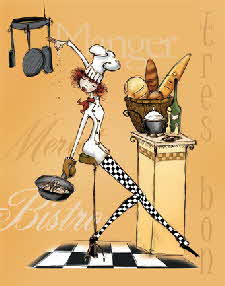PAN-FRYINGFOOD FOR THOUGHT - May 17, 2006
Mark R. Vogel - Epicure1@optonline.net - Archive of other articles by Mark Vogel Pan-frying is a dry heat cooking method whereby food is semi-submerged in hot oil in a pan on the stove top. Unlike deep frying where the food is completely immersed in oil, in pan-frying the oil’s depth is no more than half the food’s height. Another important distinction is that in pan-frying the food touches the bottom of the pan. In deep frying the food is completely suspended in oil.
The goal of pan-frying is to produce a crisp, tasty, golden-brown crust while maintaining a moist interior. This is facilitated by two factors. The first is the aforementioned contact between the food and the pan bottom. Food-to-pan abutment enables the crust to become even darker than the free-floating environment of deep frying. The second factor is the temperature of the oil. 
OK, everybody listen up. Especially you food neurotics and fat-phobes who think “frying” is a dirty word. It’s time to abandon your irrational beliefs. Frying is not nearly as “fatty” as you’d think if, and yes, this is a big if: If it is done right. Fried foods cook, in part by steaming from the inside out. The hot oil causes the internal moisture in the food to boil, which then escapes as steam. The outward rush of steam prevents the surrounding oil from permeating the food and making it greasy. This equilibrium creates that nirvana of a crunchy outside and a moist, non-oily inside. If the oil’s temperature is too low, insufficient steam is produced, the oil wins the shoving match, and your food tastes like a grease sponge. If you’ve ever received limp, greasy fries at your local fast food dump, you know what I mean. (Conversely by the way, if the oil temperature is too high, the steam wins the push-of-war and you’re food overcooks and dries out.) But if done correctly, a minimal amount of oil is absorbed into the food. You can test this by measuring the oil in the pan pre and post cooking. You’ll find the difference is not horrific and at least some of the variation is accounted for by the oil that dispersed into the air and on your countertop.
Thus, a quick recap: very hot oil causes the food’s internal moisture to turn to steam and thrust against the oil. The steam keeps the oil out, while the oil keeps the moisture in. In-between is a crisp, browned crust. What temperature should the oil be? Most foods are fried in the 350 – 375 degree range. The shallow depth of the oil used in pan-frying may preclude you from inserting a thermometer into it. Therefore, when pan-frying proteins I wait until the first whispers of smoke arise from the oil. For veggies I wait until the oil at least shimmers.
There are a few demons lurking to muck up the proper oil temperature. First, adding food to hot oil will drop the temperature of the oil. Adding a lot of food will lower it so much that it cannot recover quickly enough before sufficient steam is produced to prevent the oil from infiltrating the food. Hence, do not overcrowd the pan. It is worth the investment of time to cook a large quantity of food in batches. Second is the temperature of the food prior to cooking. Obviously the colder the food, the more the oil temperature will plummet. Allow refrigerated food to warm to room temperature before introducing it to the oil. Finally, stoves and pans vary. You’ll have to practice with your stove and your particular pans to know the optimal thermal setting to maintain accurate oil temperature. You can’t just turn the heat on high, hit the target temp and add the food. The oil will eventually overheat. You’ll have to find the sweet spot on your particular stove’s dial vis-à-vis the particular pan you are employing. Foods for pan-frying must be naturally tender cuts of meat, delicate meats like fish and shellfish, and vegetables. The food must be less than an inch thick. Thin cutlets are the best. If too thick, the surface of the food will burn before the center is cooked. Place the food in the oil, wait until the first side is browned, immediately flip it, and then cook until the second side browns. The second side requires less time since the food is hotter when flipping it than when you started it. Later batches of food will also brown sooner due to the degradation of the oil and bits of food contaminating it. However, although succeeding batches may turn brown sooner, it doesn’t mean they’re cooked sooner. Adjust accordingly, strain out errant food particles between batches, and add additional fresh oil if necessary. Do not save the oil and reuse it. Used oil has a lower smoke point and can combust sooner than fresh oil.
Foods to be pan-fried are usually covered with a batter or breading. Batters consist of dried ingredients such as flour or cornstarch in conjunction with liquids such as milk, beer, water, etc. Breadings can be as simple as dusting the food in flour or more commonly what is called the “standard breading procedure.” The standard breading procedure involves first dusting the food in flour, (taking care to shake off the excess), then dipping it in beaten eggs, and finally into bread crumbs or some other form of outer coating. Season the food with salt and pepper prior to coating. Allowing the food to rest for 15-30 minutes before frying enables the breading to stick to the food with greater tenacity.
Now that you’ve overcome your inhibitions about frying, take some veal cutlets, apply the standard breading procedure, and pan-fry them. Voila! You’ll have Veal Milanese. Pair it with a tomato and arugula salad and a bottle of Chianti. Enjoy!
| 